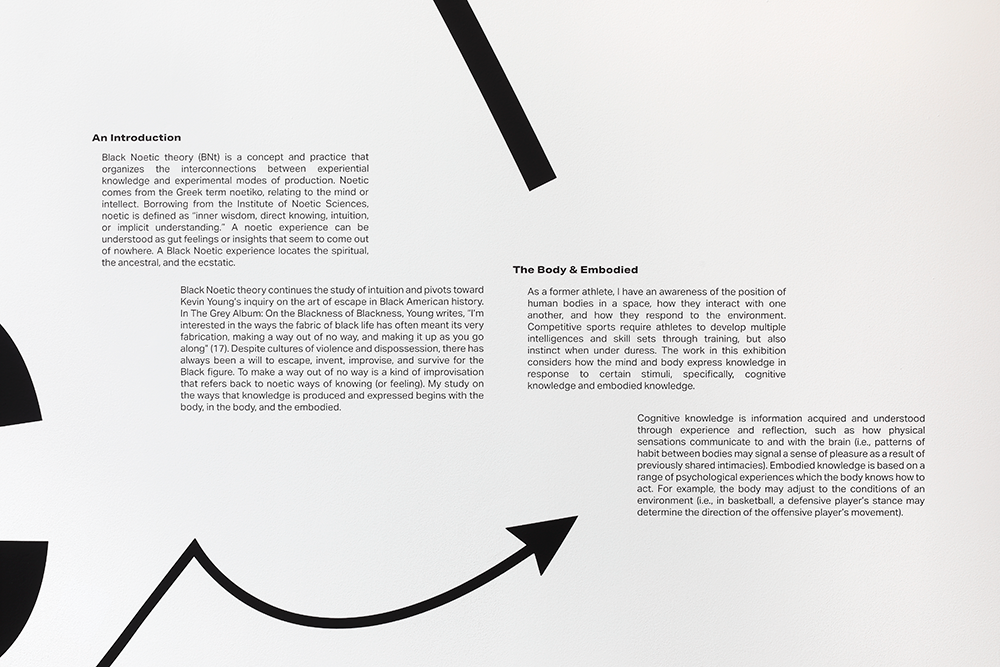BLACK NOETIC THEORY
An Introduction
Black Noetic theory (BNt) is both a methodology for art production and psychological response to human conflict, specifically for the black figure. Noetic comes from the Greek term noetiko, relating to the mind or intellect. Borrowing from the Institute of Noetic Sciences, noetic is defined as “inner wisdom, direct knowing, intuition, or implicit understanding.” A noetic experience can be understood as gut feelings, insights that seem to come out of nowhere, precognition or spiritual-ancestral linkages.
Black Noetic theory extends author Kevin Young’s inquiry on the artful dodge (or the art of escape) in black American history and culture. In The Grey Album: On the Blackness of Blackness, Young writes, “I’m interested in the ways the fabric of black life has often meant its very fabrication, making a way out of no way, and making it up as you go along” (17). Such unpredictability is a fundamental effect of cultures of violence and dispossession; however, despite the barriers, there’s always a will to survive for the black figure. “Making a way out of no way” is a kind of resourcefulness, an ingenuity referring back to intuition. Under duress, an intuitive expression or enactment is a stabilizing force for maintaining order in the precarity of black life and queer lives on the margin.
The Body & Embodied
As a former athlete, I have an awareness of the position of human bodies in a space, how they interact with others, and how they respond to an environment. Sports request a level of intellect and skill, but also instinct and an ability to improvise while under duress. I am developing Black Noetic theory as a study on embodied and cognitive knowledge through figurations of blackness, knowing, and being. Black Noetic theory as a concept and practice considers the features of Black life and Black queer lives on the margins, and attempts to organize the linkages between experiential knowledge and experimental modes of production.
I’m interested in how the mind and body express knowledge in response to certain stimuli. Embodied knowledge is based on a range of psychological experiences, in which the body knows how to act. For example, the body may adjust to the conditions of an environment (i.e., on a basketball court, a defensive player’s stance may determine the direction of the offensive player’s movement). Cognitive ways of knowing are acquired and understood through reflection, experience, and the senses, such as how physical sensations communicate to/with the brain (i.e., in intimate relations, patterns of habit between queer bodies may signal a sense of pleasure because of familiarity).
Black Noetic theory (BNt) is both a methodology for art production and psychological response to human conflict, specifically for the black figure. Noetic comes from the Greek term noetiko, relating to the mind or intellect. Borrowing from the Institute of Noetic Sciences, noetic is defined as “inner wisdom, direct knowing, intuition, or implicit understanding.” A noetic experience can be understood as gut feelings, insights that seem to come out of nowhere, precognition or spiritual-ancestral linkages.
Black Noetic theory extends author Kevin Young’s inquiry on the artful dodge (or the art of escape) in black American history and culture. In The Grey Album: On the Blackness of Blackness, Young writes, “I’m interested in the ways the fabric of black life has often meant its very fabrication, making a way out of no way, and making it up as you go along” (17). Such unpredictability is a fundamental effect of cultures of violence and dispossession; however, despite the barriers, there’s always a will to survive for the black figure. “Making a way out of no way” is a kind of resourcefulness, an ingenuity referring back to intuition. Under duress, an intuitive expression or enactment is a stabilizing force for maintaining order in the precarity of black life and queer lives on the margin.
The Body & Embodied
As a former athlete, I have an awareness of the position of human bodies in a space, how they interact with others, and how they respond to an environment. Sports request a level of intellect and skill, but also instinct and an ability to improvise while under duress. I am developing Black Noetic theory as a study on embodied and cognitive knowledge through figurations of blackness, knowing, and being. Black Noetic theory as a concept and practice considers the features of Black life and Black queer lives on the margins, and attempts to organize the linkages between experiential knowledge and experimental modes of production.
I’m interested in how the mind and body express knowledge in response to certain stimuli. Embodied knowledge is based on a range of psychological experiences, in which the body knows how to act. For example, the body may adjust to the conditions of an environment (i.e., on a basketball court, a defensive player’s stance may determine the direction of the offensive player’s movement). Cognitive ways of knowing are acquired and understood through reflection, experience, and the senses, such as how physical sensations communicate to/with the brain (i.e., in intimate relations, patterns of habit between queer bodies may signal a sense of pleasure because of familiarity).



Exhibition text documentation courtesy of the Institute for Contemporary Art at Virginia Commonwealth University
